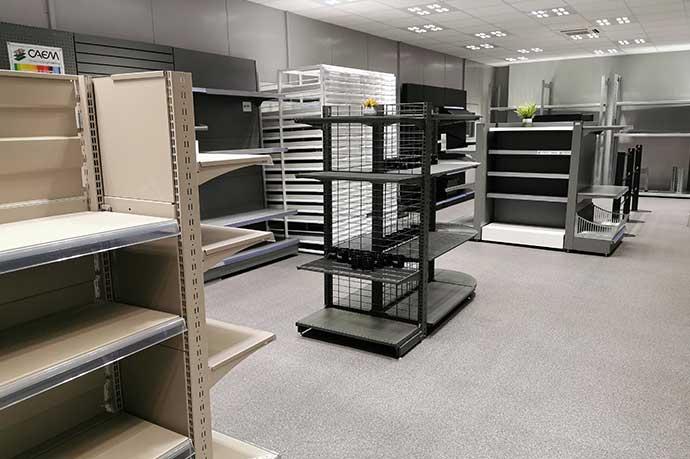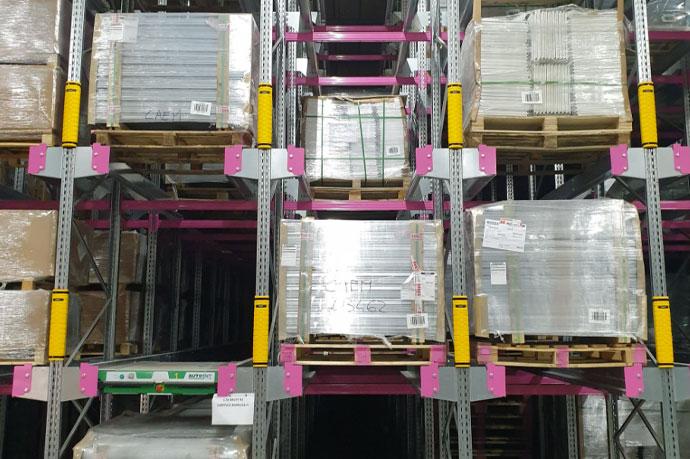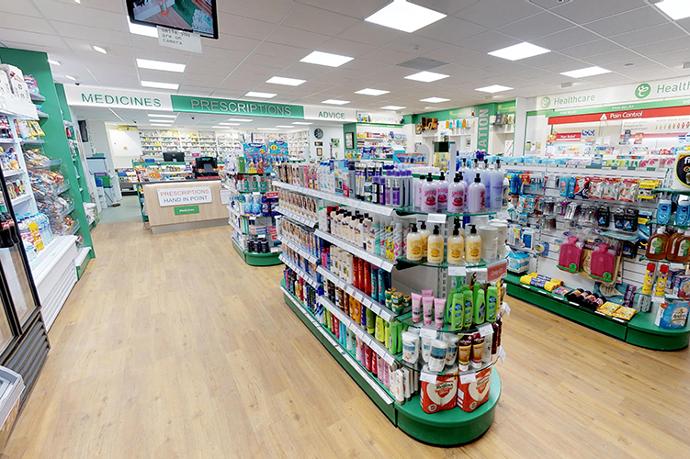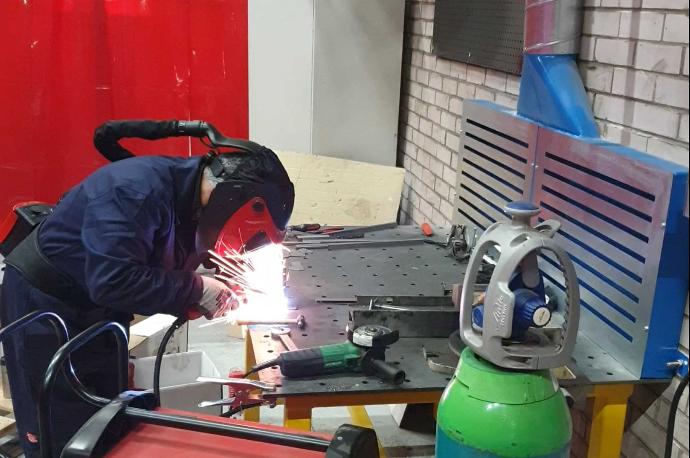https://www.caem.co.uk/wb9-industrial-modular-workbenches
In today's fast-paced work environments, being able to adapt quickly isn't just nice to have—it's essential for success. Modern workspaces need solutions that can evolve as your business needs change, which is exactly what modular workbenches offer. Research shows businesses that implement ergonomic workstation setups see an average 25% increase in productivity. Whether you're running a large industrial facility or a small workshop, CAEM's modular workbenches give you the flexibility to improve workflow while making the most of your available space.
Introduction to Modular Workbenches
Modular workbenches are a game-changer in workspace design, offering customization options that old-school fixed workstations just can't match. In busy industrial settings where adaptability drives results, CAEM's WB9 industrial modular workbenches really shine with their precision-engineered parts and sturdy build.
What makes these workbenches so special is how easily they can be reconfigured, letting businesses quickly adjust to new processes without buying completely new equipment. Research by BOSTONtec shows that ergonomic workstations can reduce cycle times by 18% and boost efficiency in lean processes by 27%. CAEM's built-in storage solutions—including adjustable shelves, heavy-duty drawers, and specialized compartments—keep everything organized and within reach, cutting down time wasted looking for tools.
CAEM's engineering team has designed these workbenches with comfort and space efficiency in mind. Each model can be adjusted between 650-1000mm in height, making them perfect for different tasks and workers of various heights. This focus on ergonomics pays off—studies show that proper workstation adjustments can increase hourly output by 16%, essentially adding an extra hour of production per shift.
These workbenches are built tough, with high-density laminate or steel worktops that stand up to chemicals, impacts, and daily wear. The frame uses 2mm thick steel tubing with powder coating for extra durability, allowing load capacities from 350kg for standard models up to 750kg for heavy-duty versions—way above what most competitors offer.
Types of Modular Workbenches
CAEM offers several specialized workbench options designed for different industry needs:
CAEM Pro Series Adjustable Workbenches feature smooth height adjustment between 650-1000mm with electric lifting mechanisms that let you change heights at the push of a button while staying stable even when fully loaded. When Johnson Electronics installed these in their assembly plant, they saw a 22% drop in worker fatigue and mistakes after just one month.
CAEM WorkStation Kits give you complete workspace solutions with pre-configured surfaces, frames, storage options, and power management. These ready-to-go kits cut setup time by up to 60% compared to building custom solutions.
For spaces needing serious organization, CAEM Storage Integration Workbenches come with modular drawer systems featuring adjustable compartments and smooth-sliding drawers that can handle up to 75kg each. They make great use of vertical space while keeping a small footprint.
CAEM Heavy-Duty Industrial Workbenches are built for tough jobs with reinforced frames that can support up to 750kg of evenly distributed weight. Using 3mm thick steel components with extra cross-bracing, they're perfect for demanding industries like automotive manufacturing. A case study from Bluco Corporation showed that using proper heavy-duty modular fixtures allowed operations to run with half the staff while doubling efficiency.
CAEM Mobile Workstations come with high-quality polyurethane wheels with individual locks, giving you mobility without wobbling. You can quickly rearrange them for changing production needs or move them exactly where they're needed, cutting down on material handling time.
For electronics work, CAEM ESD-Protected Workbenches include static-dissipative surfaces and grounding systems that maintain resistance values between 10^6 and 10^9 ohms, meeting IEC 61340-5-1 standards for static protection. Electronics manufacturers using these specialized workbenches have reduced component failures by up to 35% compared to standard workstations.
Key Features to Consider
When shopping for modular workbenches, certain features really impact how well they'll work for you, how long they'll last, and whether they're worth the investment. Understanding these elements helps you pick workbenches that actually boost productivity while meeting your specific needs.
Structural Integrity and Load Capacity is crucial for industrial use. CAEM's industrial-grade workbenches feature fully-welded steel frames with reinforced joints that exceed BS EN 1090 certification standards. With proven weight capacities from 350kg (standard models) to 750kg (heavy-duty series), these workbenches provide rock-solid platforms for demanding tasks with a built-in safety margin of 1.5 beyond their rated capacity.
Ergonomic Adaptability directly affects how productive and healthy your workers are. CAEM's height-adjustable systems let you fine-tune between 650mm and 1000mm to fit different workers and tasks. This ergonomic focus pays off—companies using properly designed workstations report nearly 40% reduction in employee turnover and much better work quality.
Modular Integration Capabilities determine how well workbenches adapt to changing needs. CAEM's patented connection system lets you add, remove, or reposition components without tools, making quick changes a breeze. This system works with over 200 compatible accessories—from document holders and monitor arms to specialized tool balancers and lighting—all using the same mounting system.
Surface Material Selection should match what you're doing. CAEM offers several worktop options:
- High-density laminate with 3mm impact-resistant edging (resists chemicals, easy to clean)
- Zinc-coated steel with powder finish (durable, moderately resistant to chemicals)
- Stainless steel 304 grade (for sterile environments, maximum chemical resistance)
- Static-dissipative composite (for electronics, 10^6 - 10^9 ohms resistance)
Storage Integration hugely impacts workflow efficiency. CAEM's modular drawer systems feature smooth-gliding full-extension slides, adjustable dividers, and uniform 50mm height increments that maximize organization while keeping everything accessible. Studies from manufacturing environments show that proper tool organization can save 15 seconds per task—adding up to 16% greater hourly output.
UKCA/CE Compliance ensures your workbenches meet current safety and quality standards. All CAEM workbenches carry appropriate certification marks in line with the Product Safety and Metrology Regulations 2024, showing they comply with both UK and EU requirements for industrial equipment.
Choosing the Right Modular Workbench for Your Needs
Picking the best modular workbench means carefully thinking about your specific operational needs and space constraints. CAEM's application engineers recommend a systematic approach to make sure your workbench selection delivers the biggest productivity improvements.
Analyze Your Workflow and Task Requirements by documenting current processes, spotting bottlenecks, and figuring out how modular workbenches could solve specific problems. Manufacturing clients who took this approach with CAEM workbenches achieved processing speeds up to 30% faster for multiple part types, as modular systems allowed quick changeover between different production needs.
Consider Space Optimization Strategies that maximize productivity in your available space. CAEM's vertical integration designs use overhead tool storage and adjustable shelving to increase usable workspace without taking up more floor space. One automotive parts manufacturer implemented CAEM's vertical storage solutions and recovered 22% of previously wasted floor space while improving parts access times.
Evaluate Adaptability Requirements based on how often your processes change. For environments that need regular reconfiguration, CAEM's quick-change worktop system lets you swap surfaces in under two minutes without tools, making it easy to shift between different materials for various processes. A contract manufacturer handling both electronics and mechanical assembly found this system cut changeover downtime by 85%.
Match Technical Specifications to Task Demands by thinking about weight requirements, environmental factors, and task-specific needs. CAEM workbenches offer:
- Standard models: 350kg capacity, great for light assembly and packaging
- Medium-duty: 500kg capacity, perfect for general manufacturing and maintenance
- Heavy-duty: 750kg capacity, designed for machining operations and heavy component assembly
All models comply with current UKCA regulations and maintain CE recognition under the Product Safety and Metrology etc (Amendment) Regulations 2024, so they meet or exceed all safety standards.
Consider Future Expansion by choosing systems that can grow with you. CAEM's standardized mounting interfaces ensure accessories you buy today will work with future workbench expansions, protecting your investment as your needs change.
Seek Expert Consultation for complex requirements. CAEM's workspace design specialists offer free workflow assessments and custom configuration recommendations based on your specific processes. These consultations have helped companies spot optimization opportunities they hadn't considered before, leading to documented productivity improvements averaging 22% after implementation.
Setting Up and Maintaining Your Modular Workbench
Setting up and maintaining your modular workbenches properly ensures you get the most productivity benefits and longest service life. CAEM's engineering team offers these proven recommendations for optimal workbench implementation:
Follow Ergonomic Placement Guidelines when positioning workbenches and accessories. Put frequently used tools and components in the primary work zone (the area you can reach without stretching or bending), and place occasionally used items in the secondary zone. This setup reduces unnecessary movement—studies show proper positioning can improve cycle time by 18% by cutting wasted motion.
Implement Standardized Assembly Procedures for consistent setup across multiple workstations. CAEM provides detailed installation guides and video tutorials that help teams assemble workbenches correctly the first time. The documentation includes torque specifications for important fasteners and verification steps to ensure stability and safety.
Configure Lighting for Task Visibility using CAEM's adjustable LED lighting accessories. Position task lighting to eliminate shadows on work surfaces, with recommended light levels of 500-750 lux for general assembly and 1000-1500 lux for precision tasks. A medical device manufacturer saw a 15% reduction in quality defects after installing CAEM's articulated lighting systems that eliminated shadows during microscopic assembly work.
Establish Regular Maintenance Schedules to extend workbench life and ensure safe operation:
- Weekly: Check for loose fasteners, clean work surfaces with appropriate cleaners
- Monthly: Lubricate moving parts (drawer slides, height adjustment mechanisms)
- Quarterly: Make sure load capacity labels are still visible, check electrical connections
- Annually: Do a complete structural inspection, tighten all fasteners to specified torque
Adapt Configurations Based on Performance Metrics by tracking productivity before and after configuration changes. CAEM's modular design allows for ongoing optimization as you identify improvement opportunities. One electronics manufacturer documented their configuration improvements over six months, eventually achieving a 28% throughput improvement through step-by-step workstation optimization.
Utilize Integrated Data Collection capabilities in CAEM's advanced workbench models. The optional productivity monitoring system tracks cycle times, tool usage patterns, and workflow interruptions, giving you actionable insights for continuous improvement. Manufacturing facilities using these data-driven approaches have identified bottlenecks that, when fixed, resulted in major efficiency gains.
Comparing Modular vs. Traditional Workbenches
Understanding how modular and traditional fixed workbenches differ helps clarify the value of CAEM's modular systems for different operational needs.
Adaptability and Reconfiguration is where modular workbenches really shine. While traditional workbenches have fixed dimensions and layouts, CAEM's modular systems can be quickly reconfigured to handle changing processes without replacement costs. A manufacturing facility that implemented CAEM workbenches saved over £75,000 in workstation replacement costs during a major production line redesign, as they simply reconfigured their existing modular components rather than buying new ones.
Initial Investment vs. Lifetime Value typically favors modular systems despite higher upfront costs. Traditional fixed workbenches usually cost 15-25% less initially but can't adapt to changing requirements without replacement. CAEM's modular workbenches show an average 35% lower total cost of ownership over 7 years when you factor in reconfiguration needs and productivity benefits.
Space Utilization Efficiency differs significantly between the two approaches. Traditional workbenches typically use only horizontal space, while CAEM's vertical integration system incorporates overhead storage, monitor mounting, and tool positioning to maximize productivity in a minimal footprint. Companies switching from traditional to modular CAEM workbenches report an average space efficiency improvement of 27% while maintaining or increasing storage capacity.
Standardization and Visual Management capabilities are naturally stronger in modular systems. CAEM's consistent component dimensions and appearance make 5S implementation and visual workplace standards easier to maintain. An automotive supplier implemented CAEM workbenches across three facilities and saw significant improvements in cross-training efficiency, as workers could easily move between standardized workstations.
Ergonomic Customization is limited in traditional workbenches but extensive in CAEM's modular systems. Being able to adjust heights, tool positions, and storage locations to individual workers' needs leads to measurable improvements in both productivity and wellbeing. Organizations using CAEM's ergonomically optimized workbenches report significant reductions in musculoskeletal complaints and related absenteeism.
Frequently Asked Questions
What lead times can I expect for CAEM modular workbenches? Standard configurations typically arrive within 2-3 weeks from order confirmation. Custom configurations needing specialized components might take 4-6 weeks. CAEM keeps high inventory levels of core components to ensure quick delivery for urgent needs.
Can CAEM workbenches be reconfigured after installation? Absolutely, all CAEM workbenches are designed for easy reconfiguration throughout their lifespan. Most adjustments can be completed with standard tools in minutes, without compromising structural integrity. The modular design ensures components can be added, removed, or repositioned as your requirements change.
What warranty coverage is provided with CAEM workbenches? CAEM workbenches come with a comprehensive 5-year warranty covering structural components and 2 years on mechanical/electrical elements. The warranty includes parts replacement and defect remediation, showing CAEM's confidence in their build quality and durability.
Are CAEM workbenches compatible with existing equipment? CAEM designs their workbenches with universal mounting interfaces that work with most standard industrial accessories and equipment. The engineering team also offers custom adaptation solutions for specialized equipment integration, ensuring compatibility with your existing operational assets.
What assembly support is available? CAEM provides detailed assembly instructions and access to video tutorials for all workbench models. For larger installations, professional assembly services are available. The modular design uses consistent assembly methods across all products, making the process simpler even for complex configurations.
How do CAEM workbenches address sustainability concerns? CAEM's modular approach naturally supports sustainability through extended product lifecycles and adaptability. Components are manufactured using highly recyclable materials, and the ability to reconfigure rather than replace workbenches significantly reduces waste. The company's manufacturing facilities also use energy-efficient processes and responsible material sourcing.





